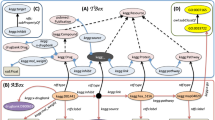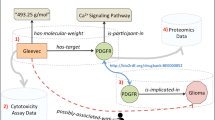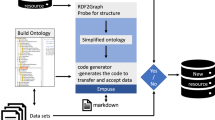Abstract
The value of any kind of data is greatly enhanced when it exists in a form that allows it to be integrated with other data. One approach to integration is through the annotation of multiple bodies of data using common controlled vocabularies or 'ontologies'. Unfortunately, the very success of this approach has led to a proliferation of ontologies, which itself creates obstacles to integration. The Open Biomedical Ontologies (OBO) consortium is pursuing a strategy to overcome this problem. Existing OBO ontologies, including the Gene Ontology, are undergoing coordinated reform, and new ontologies are being created on the basis of an evolving set of shared principles governing ontology development. The result is an expanding family of ontologies designed to be interoperable and logically well formed and to incorporate accurate representations of biological reality. We describe this OBO Foundry initiative and provide guidelines for those who might wish to become involved.
This is a preview of subscription content, access via your institution
Access options
Subscribe to this journal
Receive 12 print issues and online access
$209.00 per year
only $17.42 per issue
Buy this article
- Purchase on Springer Link
- Instant access to full article PDF
Prices may be subject to local taxes which are calculated during checkout
Similar content being viewed by others
References
Yue, L. & Reisdorf, W.C. Pathway and ontology analysis: emerging approaches connecting transcriptome data and clinical endpoints. Curr. Mol. Med. 5, 11–21 (2005).
Gene Ontology Consortium. The Gene Ontology (GO) project in 2006. Nucleic Acids Res. 34 (database issue), D322–D326 (2006).
Camon, E. et al. The Gene Ontology Annotation (GOA) Project. Genome Res. 13, 662–672 (2003).
Kohane, I.S. et al. Building national electronic medical record systems via the World Wide Web. J. Am. Med. Inform. Assoc. 3, 191–207 (1996).
Bodenreider, O. The Unified Medical Language System (UMLS): integrating biomedical terminology. Nucleic Acids Res. 32 (database issue), D267–D270 (2004).
Ceusters, W., Smith, B., Kumar, A. & Dhaen, C. Mistakes in medical ontologies: where do they come from and how can they be detected? Stud. Health Technol. Inform. 102, 145–164 (2004).
Ceusters, W., Smith, B. & Goldberg, L. A terminological and ontological analysis of the NCI Thesaurus. Methods Inf. Med. 44, 498–507 (2005).
Campbell, K.E., Oliver, D.E. & Shortliffe, E.H. The Unified Medical Language System. Toward a collaborative approach for solving terminologic problems. J. Am. Med. Inform. Assoc. 5, 12–16 (1998).
Buetow, K.H. Cyberinfrastructure: empowering a 'third way' in biomedical research. Science 308, 821–824 (2005).
Smith, B. & Ceusters, W. HL7 RIM: an incoherent standard. Stud. Health Technol. Inform. 124, 133–138 (2006).
Ashburner, M., Mungall, C.J. & Lewis, S.E. Ontologies for biologists: a community model for the annotation of genomic data. Cold Spring Harb. Symp. Quant. Biol. 68, 227–236 (2003).
Rubin, D.L. et al. National Center for Biomedical Ontology: advancing biomedicine through structured organization of scientific knowledge. OMICS 10, 185–198 (2006).
Rosse, C. & Mejino, J.L.F. The Foundational Model of Anatomy ontology. In Anatomy Ontologies for Bioinformatics (eds. Burger, A. et al.) (Springer, New York, in the press).
Haendel, M. et al. CARO: the Common Anatomy Reference Ontology. In Anatomy Ontologies for Bioinformatics (eds. Burger, A. et al.) (Springer, New York, in the press).
Leontis, N.B. et al. The RNA Ontology Consortium: an open invitation to the RNA community. RNA 12, 533–541 (2006).
Natale, D.A. et al. Framework for a protein ontology. BMC Bioinformatics [online] (in the press).
Bard, J., Rhee, S.Y. & Ashburner, M. An ontology for cell types. Genome Biol. [online] 6, R21 (2005).
Kelso, J. et al. eVOC: a controlled vocabulary for unifying gene expression data. Genome Res. 13, 1222–1230 (2003).
Mabee, P.M. et al. Phenotype ontologies: the bridge between genomics and evolution. Trends Ecol. Evol. 22, 345–350 (2007).
Whetzel, P.L. et al. The MGED Ontology: a resource for semantics-based description of microarray experiments. Bioinformatics 22, 866–873 (2006).
Whetzel, P.L. et al. Development of FuGO: an ontology for functional genomics investigations. OMICS 10, 199–204 (2006).
Golbreic, C. et al. OBO and OWL: leveraging semantic web technologies for the life sciences. In Proceedings 6th International Semantic Web Conference (ISWC 2007), (Springer, in the press).
Brinkley, J.F., Detwiler, L.T., Gennari, J.H., Rosse, C. & Suciu, D. A framework for using reference ontologies as a foundation for the semantic web. Proc. AMIA Fall Symposium, 2006, 95–100.
Lacy, L.W. Owl: Representing Information Using the Web Ontology Language (Trafford Publishing, Victoria, BC, Canada, 2005).
Smith, B., Köhler, J. & Kumar, A. On the application of formal principles to life science data: a case study in the Gene Ontology. Data Integration in the Life Sciences (DILS) Workshop 2004, 79–94.
Smith, B. et al. Relations in biomedical ontologies. Genome Biol. [online] 6, R46 (2005).
Bittner, T. & Goldberg, L.J. Spatial location and its relevance for terminological inferences in bio-ontologies. BMC Bioinformatics 23, 1674–1682 (2007).
Ramírez, M.J. et al. Linking of digital images to phylogenetic data matrices using a morphological ontology. Syst. Biol. 56, 283–294 (2007).
Schober, D., et al. Towards naming conventions for use in controlled vocabulary and ontology engineering. Bio-Ontologies Workshop, ISMB/ECCB, Vienna, 20 July 2007, 87–90.
Ruttenberg, A., Rees, J., & Zucker, J. What BioPAX communicates and how to extend OWL to help it. OWL: Experiences and Directions Workshop Series <http://owl-workshop.man.ac.uk/acceptedLong/submission_26.pdf> (2006).
Hunter, L. & Bada. M. Enrichment of OBO ontologies. J. Biomed. Inform. 40, 300–315 (2007).
Hill, D.P., Blake, J.A., Richardson, J.E. & Ringwald, M. Extension and integration of the Gene Ontology (GO): combining GO vocabularies with external vocabularies. Genome Res. 12, 1982–1991 (2002).
Mungall, C.J. Obol: integrating language and meaning in bio-ontologies. Comp. Funct. Genomics 5, 509–520 (2004).
Camon, E. et al. The Gene Ontology Annotation (GOA) Database: sharing knowledge in Uniprot with Gene Ontology. Nucleic Acids Res. 32 (database issue), D262–D266 (2004).
Blake, J., Hill, D.P. & Smith, B. Gene Ontology annotations: what they mean and where they come from. Bio-Ontologies Workshop, ISMB/ECCB, Vienna, 20 July 2007, 79–82.
Sjoblom, T. et al. The consensus coding sequences of human breast and colorectal cancers. Science 314, 268–274 (2006).
Lee, J.A. et al. Components of the antigen processing and presentation pathway revealed by gene expression microarray analysis following B cell antigen receptor (BCR) stimulation. BMC Bioinformatics [online] 7, 237 (2006).
Rebholz-Schuhmann, D., Kirsch, H. & Couto, F. Facts from text—is text mining ready to deliver? PLoS Biol. [online] 3, e65 (2005).
Witte, R., Kappler, T. & Baker, C.J.O. Ontology design for biomedical text mining. In Semantic Web: Revolutionizing Knowledge Discovery in the Life Sciences (eds. Baker C.J.O. & Cheung, K.-H.) 281–313 (Springer, New York, 2007).
Zhang, S. & Bodenreider, O. Aligning multiple anatomical ontologies through a reference. International Workshop on Ontology Matching (OM 2006) 193–197 (2006).
Luo, F. et al. Modular organization of protein interaction networks. Bioinformatics 23, 207–214 (2007).
Martone, M.E., Gupta, A. & Ellisman, M.H. E-neuroscience: challenges and triumphs in integrating distributed data from molecules to brains. Nat. Neurosci. 7, 467–472 (2004).
Fong, L. et al. An ontology-driven knowledge environment for subcellular neuroanatomy. OWL Experiences and Directions, 3rd International Workshop, Innsbruck, Austria, June 6–7, 2007 (in the press).
Taylor, C.F. et al. Promoting coherent minimum reporting requirements for biological and biomedical investigations: the MIBBI Project. Nat. Biotechnol. (in the press).
Brazma, A. et al. Minimum information about a microarray experiment (MIAME)—toward standards for microarray data. Nat. Genet. 29, 365–371 (2001).
Sansone, S.A. et al. A strategy capitalizing on synergies: the Reporting Structure for Biological Investigation (RSBI) working group. OMICS 10, 164–171 (2006).
Grenon, P., Smith, B. & Goldberg, L. Biodynamic ontology: applying BFO in the biomedical domain. In Ontologies in Medicine (ed. Pisanelli, D.M.) 20–38 (IOS, Amsterdam, 2004).
Acknowledgements
The Foundry is receiving ad hoc funding under the BISC Gen e Ontology Consortium, MGED, NCBO and RNA Ontology grants. We are grateful to all of these sources, and also to the ACGT Project of the European Union and to the Humboldt and Volkswagen Foundations.
Author information
Authors and Affiliations
Consortia
Corresponding author
Additional information
Rights and permissions
About this article
Cite this article
Smith, B., Ashburner, M., Rosse, C. et al. The OBO Foundry: coordinated evolution of ontologies to support biomedical data integration. Nat Biotechnol 25, 1251–1255 (2007). https://doi.org/10.1038/nbt1346
Published:
Issue Date:
DOI: https://doi.org/10.1038/nbt1346
This article is cited by
-
Enriching the FIDEO ontology with food-drug interactions from online knowledge sources
Journal of Biomedical Semantics (2024)
-
Towards a Terminologia Anatomica Humana
Anatomical Science International (2024)
-
Mining of EHR for interface terminology concepts for annotating EHRs of COVID patients
BMC Medical Informatics and Decision Making (2023)
-
Comparing methods for drug–gene interaction prediction on the biomedical literature knowledge graph: performance versus explainability
BMC Bioinformatics (2023)
-
Development and validation of the early warning system scores ontology
Journal of Biomedical Semantics (2023)



